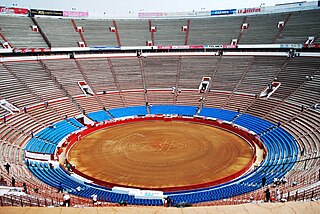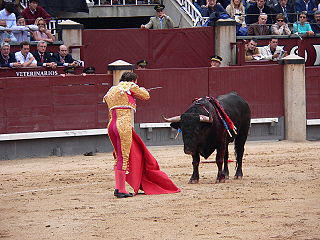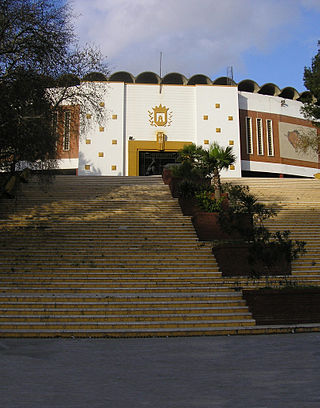
The Plaza de Toros de Las Ventas, known simply as Las Ventas, is the largest bullfighting ring in Spain, located in the Guindalera quarter of the Salamanca district of Madrid. It was inaugurated on June 17, 1931. Its seating capacity of 23,798, makes it the third-largest bullfighting run in the world, after bullrings in Mexico and Venezuela. After the federal ban of bulfighting in Plaza México, Las Ventas is the second largest bullring in the world still in operation for its original intention.

Pedro Romero Martínez was a legendary bullfighter from the Romero family in Ronda, Spain.

A bullring is an arena where bullfighting is performed. Bullrings are often associated with the Iberian Peninsula, but they can also be found through Iberian America and in a few Spanish and Portuguese ex-colonies in Africa. Bullrings are often historic and culturally significant centres that bear many structural similarities to the Roman amphitheatre.

The Plaza de toros México, situated in Mexico City, is the world's largest bullring. This 41,262-seat facility is usually dedicated to bullfighting, but many boxing matches have been held there as well, including Julio César Chávez's third and final bout with Frankie Randall on May 22, 2004. The Plaza México replaced the ancient bullring Toreo de la Condesa in the Condesa neighborhood that was overwhelmed by the rapid growth of population in the capital. It opened on 5 February 1946 and annually since then, that date marks the date of the Corrida de Aniversario. This building was built beside the football stadium Estadio Ciudad de los Deportes.

The Plaza de Toros de Ronda is a Bullring in Ronda, it has a diameter of 66 metres (217 ft), surrounded by a passage formed by two rings of stone. There are two layers of seating, each with five raised rows and 136 pillars that make up 68 arches. The Royal Box has a sloping roof covered in Arabic tiles. The design of the main entrance to the bull ring features two Tuscan columns and the royal shield of Spain surround by baroque edging. The main door is large enough to allow horses and carriages to enter the ring, and above the door is an iron wrought balcony that embodies the bullfighting culture.

Espinal is a Colombian municipality and town located in the Department of Tolima, 146 km southwest from Bogotá. It is the second most important town of the department and is the rice capital of the center of the country. It is flanked by the Magdalena and Coello rivers. El Espinal is known for the manufacture of typical musical instruments and its cuisine is known for tamales and the suckling pig, which are the typical dishes of the region. It has a total area of 231 km2, an urban area of 4.26 km2, and a rural area of 212.74 km2.

The plaza de toros de la Real Maestranza de Caballería de Sevilla is a 12,000-capacity bullring in Seville, Spain. During the annual Seville Fair in Seville, it is the site of one of the most well-known bullfighting festivals in the world. It is a part of the Real Maestranza de Caballería de Sevilla, a noble guild established for traditional cavalry training.

The Plaza de Torosde Acho is the premier bullring in Lima, Peru. Located beside the historical center of the Rímac District, the plaza is classified as a national historic monument. It is the oldest bullring in the Americas and the second-oldest in the world after La Maestranza in Spain. It opened on 30 January 1766.
Jaime Bravo was a Mexican matador during the 1950s and 1960s. Bravo was known for his death-defying style and numerous relationships with various women and Hollywood starlets.

Spanish-style bullfighting is a type of bullfighting that is practiced in several Spanish-speaking countries: Spain, Mexico, Ecuador, Venezuela, Peru, as well as in parts of southern France and Portugal. In Colombia it has been outlawed but is being phased out with a full ban coming in effect in 2027. This style of bullfighting involves a physical contest with humans attempting to publicly subdue, immobilize, or kill a bull. The most common bull used is the Spanish Fighting Bull, a type of cattle native to the Iberian Peninsula. This style of bullfighting is seen to be both a sport and performance art. The red colour of the cape is a matter of tradition – bulls are color blind. They attack moving objects; the brightly-colored cape is used to mask blood stains.

Bullfighting is a physical contest that involves a bullfighter attempting to subdue, immobilize, or kill a bull, usually according to a set of rules, guidelines, or cultural expectations.
Bullfighting was banned in the Spanish autonomous community of Catalonia by a vote of the Catalan Parliament in July 2010. The ban came into effect on 1 January 2012. The last bullfight in the region took place on 25 September 2011 at La Monumental. The ban was officially annulled for being unconstitutional by Spain's highest court on 5 October 2016. However, despite the overturning of the ban, no further bullfight had taken place in Catalonia as of July 2020.

The Plaza de Toros Monumental de Barcelona, often known simply as La Monumental, is a bullring in the city of Barcelona, Catalonia, Spain. It was the last bullfighting arena in commercial operation in Catalonia. It was inaugurated in 1914 under the name Plaza de El Sport and was soon expanded and given its current name in 1916. It is situated at the confluence of the Gran Via and Carrer Marina in the Eixample district. It has a capacity of 19,582 within 26 rows of lines, boxes, and stands on the first floor inside and an upper gallery surrounding the building.

Plaza de toros de Las Palomas, officially Monumental Las Palomas, is a bullring in Algeciras at the southern end of Spain. The current building was built in 1969 and it can hold over 11,000 spectators.

La Malagueta is a bullring at Málaga, Andalucía, Spain. It is located in the eastern district of Málaga, in its namesake neighbourhood of La Malagueta.

The Coliseum Burgos, formerly named as Plaza de Toros de Burgos, is an indoor arena mainly used as bullring located in Burgos, Spain.

Santa Cruz Bullring is a bullring in Santa Cruz de Tenerife, Spain. Opened in 1893, it hosted its last bullfight in 1983. After being used for a variety of other events it closed in 2003, and is now vacant, with potential plans to redevelop it. It was listed as a Bien de Interés Cultural in 2014.

Hilda Eliana Tenorio Patiño is a Mexican bullfighter and matador. She was the first woman to receive her alternativa in the Plaza de Toros México, the largest bullring in the world, aged 24. Tenorio completed her alternativa on February 28, 2010. She has been an outspoken advocate of feminism in the sport. She is the third Mexican woman to attain the rank of matador.

The Plaza de Toros de Pontevedra (Spain) is the bullring of the Spanish city of Pontevedra and the only one in the autonomous community of Galicia. It has a capacity of 7,800 spectators and is classified as the second category of Spanish bullring. The current bullring replaced a wooden one dating from 1892, although the tradition of bullfighting in Pontevedra dates back to the 17th century.
Simão Luís da Veiga Jr.OC was a celebrated bullfighting horseman and farmer from Portugal.


















